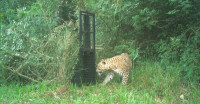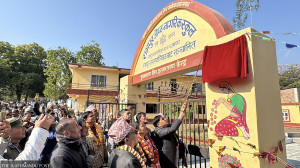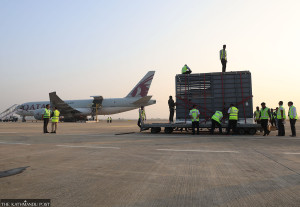Lumbini Province
Construction of cobblestone path around Jagadishpur Lake raises concern of biodiversity loss
The project was launched without conducting an environmental impact assessment.
Manoj Paudel
The Department of Tourism has started to construct a path around Jagadishpur Lake in Kapilvastu in order to boost tourism activities.
The construction project, however, was approved without conducting an environmental impact assessment (EIA), according to Badganga Irrigation Division Office.
The contract was issued by the Department of Tourism to Kalpabriksya/Jalukeni JV Kathmandu and the work began on July 6.
Ram Krishna Ghorasaine, chief of the irrigation division office, said that the Department of Tourism and the contractor company failed to coordinate with the division before starting the construction works.
“No infrastructure can be constructed in the lake area without the EIA study. But the contractor company has begun constructing the cobblestone path around the lake,” said Ghorasaine.
Besides constructing the path around the lake, Kalpabriksya/Jalukeni JV Kathmandu has also agreed to build a park in the area. The project is set to be completed by October 2020.
In August 2003, the lake, which is home to many bird species, was recognised as a Ramsar wetland site. The lake, which is spread over an area of 157 hectares, lies 11km north of Taulihawa, the headquarters of Kapilvastu district.
The lake also falls under the jurisdiction of the Department of National Park and Wildlife Conservation. But the Division Forest Office in Kapilvastu has remained silent regarding the construction work in the lake area.
“No work can be done in Ramsar wetland site without conducting environment assessment,” said Bishnu Prasad Shrestha, under secretary of the Department of National Park and Wildlife Conservation. “I will inquire about the details of the construction work with district officials.”
According to conservationists, the path is being constructed 2.5 meters down the service road.
“The proximity of the path to the lake will disturb wildlife habitat such as the birds that nest in the lake area,” said Dinesh Giri, an ornithologist.
Another ornithologist Hem Sagar Baral said that infrastructures should not disturb biodiversity.
“This area houses several species of birds, and their well-being and protection must be kept in mind before initiating any construction work in the area,” said Baral.
However, Shiva Bahadur Wagle, local ward chairman, has a different view regarding the construction of path and park at the Ramsar wetland site.
“This is a positive move. Beautification of the area will attract tourists which will help locals generate income. The place is a destination for bird-watching enthusiasts. Its tourism potential must be utilised,” he said.
Lalit Gurung, chairman of the Jagadishpur Lake Management Forum, also claimed that building a path around the lake will not affect the lake’s biodiversity.
“We should not miss a chance to develop the lake into a major tourist destination of Province 5,” Gurung said.
According to conservationists, of the 872 bird species found in Nepal, more than 164, including grebes, cormorants, herons, egrets, stork, ducks and geese, terns and gulls, are found in the lake.
Birds migrate to this lake from Siberia, China, Russia, Mongolia, Turkmenistan and Kyrgyzstan with the start of the winter and they stay here until February. More than 22,000 birds including Gadwall, Lesser Whistling duck, Tufted duck, Ferruginous duck, Northern pintail, Northern shoveler, Eurasian Wigeon, Common Pochard, and Cotton Pygmy-goose are found in the Jagadishpur lake.




 8.12°C Kathmandu
8.12°C Kathmandu











